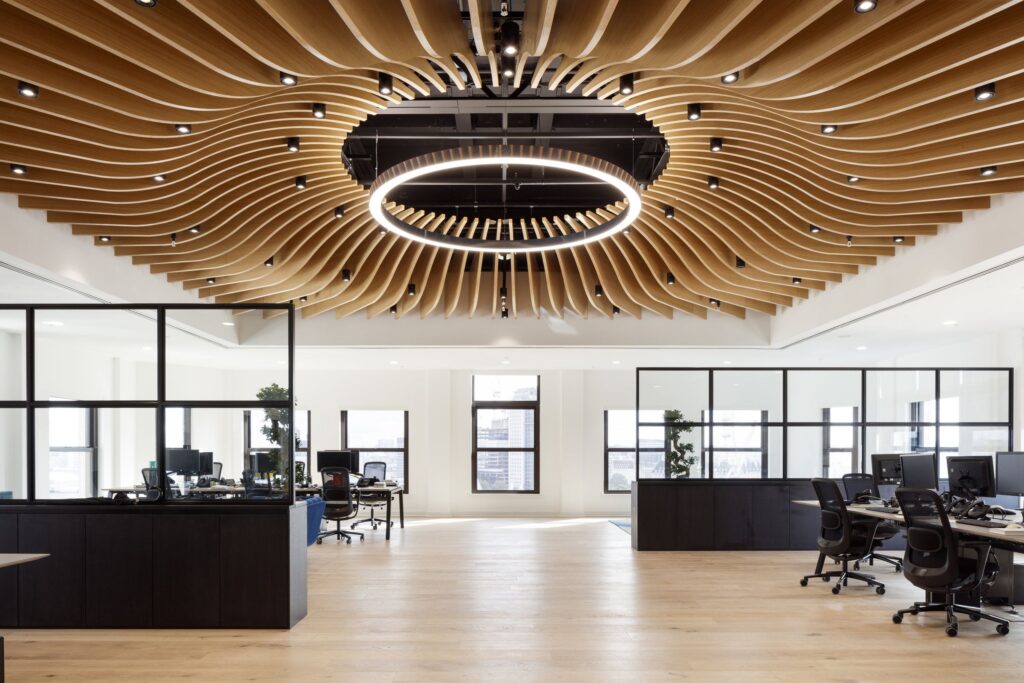When it comes to designing an office space, one of the most crucial yet often overlooked aspects is the false ceiling. The right materials for office false ceiling not only enhance the aesthetic appeal but also improve the functionality and comfort of the workspace. In this blog, we’ll guide you through the key considerations to help you choose the perfect materials for your office’s false ceiling, ensuring a balance between style, durability, and practicality.
Understanding the Importance of False Ceilings

False ceilings, also known as drop ceilings or suspended ceilings, are a secondary layer of ceiling installed below the main structural ceiling. They serve multiple purposes, including:
Aesthetic Enhancement: False ceilings can dramatically change the look and feel of an office by adding depth, texture, and character to the space.
Acoustic Control: Properly chosen materials can help absorb sound, reducing noise levels and creating a more focused work environment.
Temperature Regulation: False ceilings can improve insulation, making the office more energy-efficient by helping to maintain a consistent temperature.
Concealing Wiring and Ductwork: They provide an easy way to hide unsightly wires, pipes, and ductwork, ensuring a clean and organized appearance.
Key Factors to Consider When Choosing Materials for Office False Ceiling

Acoustic Properties
One of the most important factors to consider is how the material will affect the acoustics of your office. Materials like mineral fiber and acoustic ceiling tiles are excellent choices for reducing noise levels, which is particularly important in open-plan offices.
Durability and Maintenance
Durability is crucial in ensuring that the false ceiling remains in good condition over time. Materials such as gypsum and metal are known for their long-lasting properties and require minimal maintenance. They are also resistant to moisture and fire, making them ideal for offices in humid climates or those that need to adhere to strict fire safety regulations.
Aesthetic Appeal
The visual impact of the false ceiling cannot be overstated. Materials like PVC, wood, and gypsum offer a variety of design options, from sleek, modern finishes to more traditional, textured looks. Consider the overall design theme of your office when selecting materials to ensure harmony between the ceiling and other elements of the interior design.
Thermal Insulation
Choosing the right materials for your office’s false ceiling can also contribute to energy efficiency. Materials like mineral wool and foam can provide excellent thermal insulation, reducing the load on your HVAC system and lowering energy costs. This is particularly beneficial in larger office spaces where energy savings can be substantial.
Budget Considerations
The cost of materials can vary widely, so it’s important to select materials that meet your functional needs without exceeding your budget. Gypsum is a cost-effective option that offers a good balance of aesthetics and functionality, while metal ceilings, though more expensive, provide superior durability and a sleek, modern look.
Popular Materials for Office False Ceiling
Gypsum
Gypsum boards are lightweight, easy to install, and offer a smooth finish. They are ideal for creating modern, minimalist designs and are also fire-resistant.
Mineral Fiber
Mineral fiber tiles are excellent for acoustic control and are often used in offices to reduce noise levels. They are also resistant to moisture and can be easily replaced if damaged.
Metal
Metal ceilings, typically made from aluminium or steel, are highly durable and offer a sleek, industrial look. They are also fire-resistant and easy to clean.
Wood
Wood panels or planks can add warmth and elegance to an office space. They are versatile and can be used to create both traditional and contemporary designs. However, they require more maintenance compared to other materials.
PVC
PVC ceiling panels are lightweight, moisture-resistant, and come in a variety of finishes. They are a budget-friendly option that can mimic the look of wood or metal without the high cost.
Conclusion
Choosing the right materials for office false ceiling is a critical decision that impacts both the aesthetics and functionality of your workspace. By considering factors such as acoustic properties, durability, aesthetics, thermal insulation, and budget, you can select the best materials that meet your needs and enhance the overall environment of your office.
Remember, the right materials for office false ceiling not only elevate the visual appeal of your space but also contribute to a more comfortable and productive working environment. Take the time to explore your options and invest in materials that align with your office’s design goals and operational needs. Explore the possibilities of false ceilings and transform your interiors today! Connect with us today


